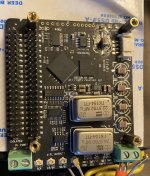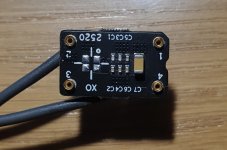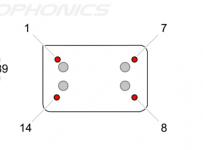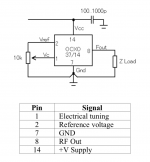Му 5v adapter for FifoPi.
For synchronization, I had to connect to 2 power supplies (minus the common one) and put high-quality resistors on the 75-150 Ohm frequency output.
And I changed the 14p socket on fifopi for 16p, so that you could easily switch and turn on the power separately from the fifopi.
For synchronization, I had to connect to 2 power supplies (minus the common one) and put high-quality resistors on the 75-150 Ohm frequency output.
And I changed the 14p socket on fifopi for 16p, so that you could easily switch and turn on the power separately from the fifopi.
Attachments
Last edited:
Hi Wlowes, well maybe we just hear the same, but the way we describe it is different?
I tend to be more holding back and cautious in my wording, where others are more expressive. Nothing wrong with that. I believe as a reviewer you need to stay consistent in the things you describe. The same goes for Audio Magazines for example... But it is very much ok if the wording is different in my opinion.
But basically we had the same experience and that is reassuring 🙂
Today was not my day to be honest. I was distracted and just blew up my ReclokPI an hour ago.... the very last connection I made before finally closing the the DAC Chassis was not the 3,3 Volt wire but a 12 Volt 😱
---- pssshhht and smoke ------ So need to wait again now to finish my DAC....
well it is a hobby and sh*****t like this happens so now and than
.
@dddac
Sorry about that. It won't damage anything on ReclockPi if it was a 5V.
But for a 15V ........ just enjoy the firework🙂
Please let me know if there is anything I can help you with.
Regards,
Ian
All quite possible. Clear that we all hear similar things with improved clock phase noise. I suspect that I simply had an issue with connection that was also degrading the clock signal. Hitting two birds with one stone could explain the difference in our perception.Hi Wlowes, well maybe we just hear the same, but the way we describe it is different?
I tend to be more holding back and cautious in my wording, where others are more expressive. Nothing wrong with that. I believe as a reviewer you need to stay consistent in the things you describe. The same goes for Audio Magazines for example... But it is very much ok if the wording is different in my opinion.
But basically we had the same experience and that is reassuring 🙂
I think you describe these things well. I often make changes that I need to listen hard to discern if it is there or imagined. Other times hits you smack in your face that it changed. Instantly heard and takes a while to become the new normal. SinePi was closer to the later in my experience.
Sorry to hear that. I know the feeling only too well. At least you have the skills and equipment to chase down and replace parts if you choose.Today was not my day to be honest. I was distracted and just blew up my ReclokPI an hour ago....
.
I myself live in Russia. I called the Mxtall plant. But I chose others, ГК154 manufacturer in Moscow. Кварцевые генераторы :: Производство и Поставки :: ООО НПФ БМГ ПЛЮС In terms of characteristics, they are not inferior to MXO37 / 14 and sound great! But they cost around $ 50 🙂
I use it on 22 and 24 with fifopi. I only have a table of 36 for comparison. Now I want to buy myself another 5.6 and 6.1, but the minimum batch is 3 pieces of each frequency. I also think about group purchases.
But for maximum performance they need 5v. (3.3v support too).
I thought about those Russian clocks since they seem to have a official sales channel on eBay on the link you sent last year, but the MagicXtal will still be in the back of my mind. It's good to have options.
I'm not an incremental upgrade type. I rather go all out the first time around as incremental upgrades cost more in the long run.
Because the MagicXtal has 5 legs, I think I'm going to give up. It's just too much risk for my DIY skill level because if I order a single parameter wrong the whole project falls apart. MOQ1 maybe, but MOQ5 too much risk.
I'm giving up too on a transportable as that will be converted to an Andrea Mori rig. Of course slash Ian rig.
But I will eventually build a portable RPi 4A/5A with a FiFoPi Q4, so the eBay Russian clocks may fit that need since it's basically used to stream wireless into an iPhone. The Accus do a good job, but I like to take advantage of being able to scale clocks with a future Q4 (hopefully with a built-in ReClockPi). Thanks for sharing the photos.
I listened to streaming direct to iPhone and I definitely prefer a clocked source. So the Russian clock may fit in perfectly on that future build.
Anyways, I'm planning to take the whole 2022 off to just implement and enjoy. Not be posting unless I need serious help and guidance. So maybe one day I will pop in with these Russian clocks.
Last edited:
@wlowes. I finally broke out the soldering iron after a long break.
Any tips on soldering the Crystal to Andrea's board?
Are the wires supposed to be independent or in a crisscross arrangement? I'm worried the crisscross will short, but that's what is recommended in the manual?
I have a fairly straightforward implement as it's a finished board. I just haven't thought about the soldering until now as I was open to selling before acquiring a SinePi.
Any tips on soldering the Crystal to Andrea's board?
Are the wires supposed to be independent or in a crisscross arrangement? I'm worried the crisscross will short, but that's what is recommended in the manual?
I have a fairly straightforward implement as it's a finished board. I just haven't thought about the soldering until now as I was open to selling before acquiring a SinePi.
Wow 749 pages! I haven't read it all, but I wonder why the TO started with such a large RAM? Jitter is usually in the sub 1 clock cycle range as far as FPGA outputs are concerned. The rest comes from the input and the driving oscillator and its long term stability. When the thread started in 2011, I was working with a DE-2-115 from Terasic outputting I2S signals to my modules. I found a stability of 2-5 clock cycles that time - referenced to 96kHz. In the meantime I'm using 384 and I didn't find more than 5ccs / long term drift when measuring (for 5 Hz lower cutoff frequency = 200ms) either.
The key thing here was what the modules made of the I2S. There is a lot that can be done, especially with the simple modules. The easiest way to eliminate this is to use an external oscillator to drive the whole system and read the output of the FPGA from an 8-word FIFO buffer. Then it doesn't really matter what noise the FPGA imprints on its outputs. Only the MCLK is relevant. All others can be derived from the FPGA outputs (gladly with jitter).
I use a timing module built by one of my customers, formerly for a particle accelerator, to synchronize all modules in different rooms, and which is similar to those used in RF test labs. However, I can't sell that. My current customer is a chip test equipment manufacturer and has very high accuracy clocks in the 30GHz range. But for their price you can buy a complete recording studio 🙂
So I am very interested in the discussion about these Russian frequency clocks.
Translated with www.DeepL.com/Translator (free version)
The key thing here was what the modules made of the I2S. There is a lot that can be done, especially with the simple modules. The easiest way to eliminate this is to use an external oscillator to drive the whole system and read the output of the FPGA from an 8-word FIFO buffer. Then it doesn't really matter what noise the FPGA imprints on its outputs. Only the MCLK is relevant. All others can be derived from the FPGA outputs (gladly with jitter).
I use a timing module built by one of my customers, formerly for a particle accelerator, to synchronize all modules in different rooms, and which is similar to those used in RF test labs. However, I can't sell that. My current customer is a chip test equipment manufacturer and has very high accuracy clocks in the 30GHz range. But for their price you can buy a complete recording studio 🙂
So I am very interested in the discussion about these Russian frequency clocks.
Translated with www.DeepL.com/Translator (free version)
@A123
The yellow Eaton XL60-3R0308T-R 3000F ultracapacitors are rated 3V. But when work with UcPure 3.3V configuration, the maximal working voltage at each cap will be around 1.7V. The headroom will be 1.6V. I this case, I don't think the balance board will be necessary. But I could be wrong. I'll keep watching the voltage over each caps to see how much voltage difference it can be.
Ian
Hello,
100% correct i guess. If not all the UcHybrid boards have been made with the wrong '' mindset '' . If things go wrong with the '' small ones '' damage will be similar to the damage caused by 3000F caps. Both will supply enough current to fry everything.
I remember Doede wrote somewhere that with a bunch of CHEAP caps in series voltages across the different caps were far apart but with quality parts and just two in series voltages should be pretty close.
Greetings, Eduard
I have these resistors in my Mouser UcPure 5V project. If there's objections, please let know.
https://www.mouser.com/ProductDetai...GAEpiMZZMtlubZbdhIBINZyO39%2BOXIfNp4z8OCYYmc=
https://www.mouser.com/ProductDetail/Panasonic/ERJ-UP3F1102V?qs=GedFDFLaBXGOZENR/Q%2BLAQ==
https://www.mouser.com/ProductDetai...GAEpiMZZMtlubZbdhIBINZyO39%2BOXIfNp4z8OCYYmc=
https://www.mouser.com/ProductDetail/Panasonic/ERJ-UP3F1102V?qs=GedFDFLaBXGOZENR/Q%2BLAQ==
Attachments
Last edited:
GK154 briefly mentioned here:
AMB Laboratories DIY Audio Forums • View topic - Pulsar Clock
somewhere since the middle of summer I also use these clocks together with fifopi. They are much, much better than the accusilicons or Crystek 957 that I had before, and I must admit that this is a completely different level!
the positive aspects also include responsiveness to various modifications: power supply, they can work at 3.3v, but with 5V the result is completely different much better,
power filtering to exclude mutual influence is also provides good results, vibroisolation, power supply from batteries, and many others .. all of these mods are well audible.

@alecm
Looks awesome. Thanks for sharing and your endorsement of these clocks. Sample size is low here, so having a second person endorse these will motivate me to try when the upgraditis itch hits (currently running Accus). It should be a good clock complement for a second system future build after a Andrea Mori clock primary build.
I believe I will play it safe and go with 3.3v since it will be for portable use. If it was my primary non-portable then I would consider 5V.
Note: I'm on the fence whether or not to try to sell the Andrea Mori clock since I'm already happy with my Accu system. So this will help in that decision as this will be a middle ground solution between Accus and the Andrea Mori clock.
Looks awesome. Thanks for sharing and your endorsement of these clocks. Sample size is low here, so having a second person endorse these will motivate me to try when the upgraditis itch hits (currently running Accus). It should be a good clock complement for a second system future build after a Andrea Mori clock primary build.
I believe I will play it safe and go with 3.3v since it will be for portable use. If it was my primary non-portable then I would consider 5V.
- 10 Hz -115 dbc/Hz
- 100 Hz -142 dbc/Hz
- 1 kHz -156 dbc/Hz
- 5 kHz -162 dbc/Hz
- 10 kHz -163 dbc/Hz
- 100 kHz -165 dbc/Hz
- 1 MHz -165 dbc/Hz
- 10 MHz -162 dbc/Hz
Note: I'm on the fence whether or not to try to sell the Andrea Mori clock since I'm already happy with my Accu system. So this will help in that decision as this will be a middle ground solution between Accus and the Andrea Mori clock.
Last edited:
somewhere since the middle of summer I also use these clocks together with fifopi. They are much, much better than the accusilicons or Crystek 957 that I had before, and I must admit that this is a completely different level!
the positive aspects also include responsiveness to various modifications: power supply, they can work at 3.3v, but with 5V the result is completely different much better,
power filtering to exclude mutual influence is also provides good results, vibroisolation, power supply from batteries, and many others .. all of these mods are well audible.
View attachment 997699
Dear @alecm
Very interesting, where do you buy this clock?
Many Thanks
On ebay, one private trader sold, but now he has sold everything. And you can only order from the factory (min. 3 pcs. of one frequency).
I want to order for myself for 5 and 6. GB can be arranged. Perhaps there will be those who wish.
I want to order for myself for 5 and 6. GB can be arranged. Perhaps there will be those who wish.
5 and 6 is perfect, but I'm 3.3v. I doubt you can mix as I believe you are 5v?
I'm looking for just a drop-in replacement.
Anyways, this is for a future build so I'll be on the lookout for these. If eBay is out, that may not be a bad thing. Maybe new stock is on the way since these clocks have been out in the wild for a while. And I doubt eBay will have 5,6 only mainstream 22,24 or 44,48.
I'm looking for just a drop-in replacement.
Anyways, this is for a future build so I'll be on the lookout for these. If eBay is out, that may not be a bad thing. Maybe new stock is on the way since these clocks have been out in the wild for a while. And I doubt eBay will have 5,6 only mainstream 22,24 or 44,48.
Last edited:
RPi 4 and PRi Zero2 W software compatible issues
Just found some RPi 4 and PRi Zero2 W are not compatible with some current software player such as Volumio. If that's the case, FifoPi may not work correctly because the I2S/DSD signals from the GPIO could be already wrong.
1. Some RPi 4 can not boot for current software such as Volumio V2.917 or earlier.
2. Even boot occasionally, it may have problem with playing DSD music over DoP, or has wrong Fs.
3. The new RPi Zero2 W can not boot.
The possible solution would be using the most updated V3.129 Beta version of Volumio, which can be download here:
https://updates.volumio.org/pi/volumiobuster/3.129/Volumiobuster-3.129-2021-10-29-pi.zip
Other software may have the similar issues because RPi4 and PRI Zero2 has the new designed architectures.
Just hope this information helps.
Regards,
Ian
Just found some RPi 4 and PRi Zero2 W are not compatible with some current software player such as Volumio. If that's the case, FifoPi may not work correctly because the I2S/DSD signals from the GPIO could be already wrong.
1. Some RPi 4 can not boot for current software such as Volumio V2.917 or earlier.
2. Even boot occasionally, it may have problem with playing DSD music over DoP, or has wrong Fs.
3. The new RPi Zero2 W can not boot.
The possible solution would be using the most updated V3.129 Beta version of Volumio, which can be download here:
https://updates.volumio.org/pi/volumiobuster/3.129/Volumiobuster-3.129-2021-10-29-pi.zip
Other software may have the similar issues because RPi4 and PRI Zero2 has the new designed architectures.
Just hope this information helps.
Regards,
Ian
Last edited:
Have a question if you mind please. Does the last FifoPi Rpi hat has several I2S outputs that can be used at the same time ? For instance to feed a two channel DAC or more and that respect the convolotion channels splitting that coulf be sent through the USB input of the Rpi or via its input network ?
@diyiggy
My McFifo/McDualXO were designed exactly for that job, if I'm not wrong.
SinePi solution also works for McFifo/McDualXO.
FifoPi could be possible for two DACs from both GPIO and u.fl (independent outputs), you can try if you really want.
Regards,
Ian
My McFifo/McDualXO were designed exactly for that job, if I'm not wrong.
SinePi solution also works for McFifo/McDualXO.
FifoPi could be possible for two DACs from both GPIO and u.fl (independent outputs), you can try if you really want.
Regards,
Ian
Last edited:
- Home
- Source & Line
- Digital Line Level
- Asynchronous I2S FIFO project, an ultimate weapon to fight the jitter






